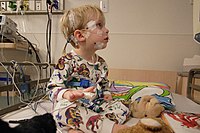
Photo from wikipedia
BACKGROUND There is evidence linking restless legs syndrome (RLS) with increased blood pressure (BP), but the mechanism of this relation remains unclear. Is the BP increased due to some features… Click to show full abstract
BACKGROUND There is evidence linking restless legs syndrome (RLS) with increased blood pressure (BP), but the mechanism of this relation remains unclear. Is the BP increased due to some features of RLS or to deterioration of sleep caused by RLS? This study compared values of nocturnal BP in patients with RLS and patients with insomnia. If increased BP in RLS is a consequence of disordered sleep, then it should be similar to increased BP in insomnia. METHODS Polysomnographic recordings of patients admitted to a sleep center with RLS or insomnia were analyzed. Demographic and clinical data, objective sleep parameters, and nocturnal BP were compared. RESULTS Recordings of 35 patients with RLS and 33 patients with insomnia were analyzed. The groups did not significantly differ in terms of demographic traits or prevalence of other comorbidities. Patients with RLS had significantly higher systolic BP during the night (122.4 ± 13.8 vs 116.3 ± 13.4; p = 0.03) and during sleep (121.4 ± 13.3 vs 115.7 ± 13.3; p = 0.04). The only significant difference in sleep architecture was an increased number of periodic limb movements in sleep (PLMS) and PLMS with arousal in the RLS group (25.5 ± 24.6 vs 13.9 ± 22.7; p = 0.02 and 4.7 ± 5.4 vs 2.1 ± 3.4; p = 0.01). CONCLUSION Our results suggest that patients with RLS have higher nocturnal BP than patients with insomnia, and that increased PLMS is related to the increase in BP.
Journal Title: Sleep medicine
Year Published: 2017
Link to full text (if available)
Share on Social Media: Sign Up to like & get
recommendations!